Financial Management Practices in Public Sector: Supply Chain, Budgeting, Asset Management
VerifiedAdded on 2023/06/03
|10
|2363
|413
AI Summary
This article discusses the importance of financial management practices in the public sector, including supply chain management, budgeting, and asset management. It provides a case analysis of Emirates airlines and how these practices contribute to effective financial management. The article emphasizes the need for effective financial management to attain organizational objectives and profitability.
Contribute Materials
Your contribution can guide someone’s learning journey. Share your
documents today.
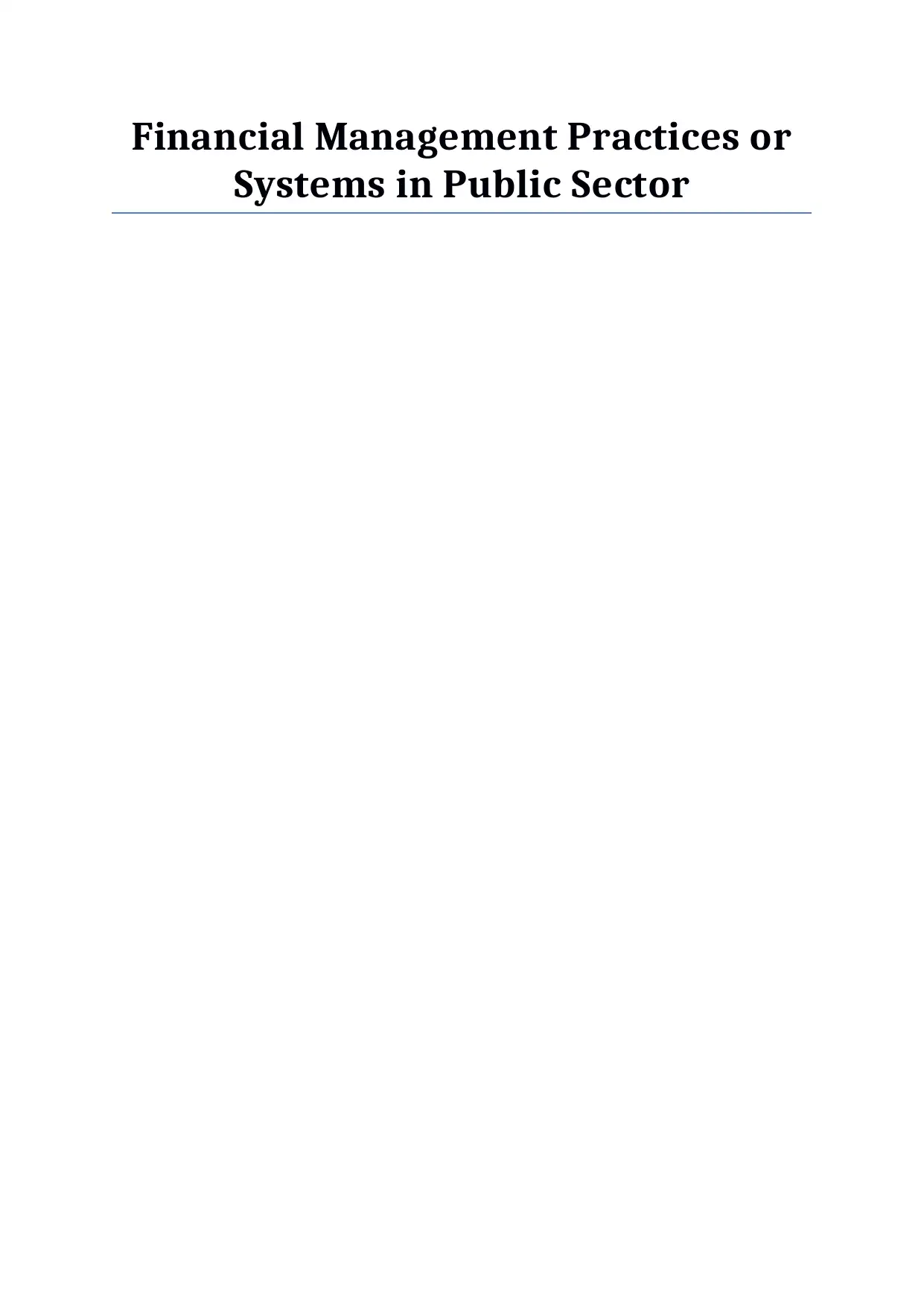
Financial Management Practices or
Systems in Public Sector
Systems in Public Sector
Secure Best Marks with AI Grader
Need help grading? Try our AI Grader for instant feedback on your assignments.
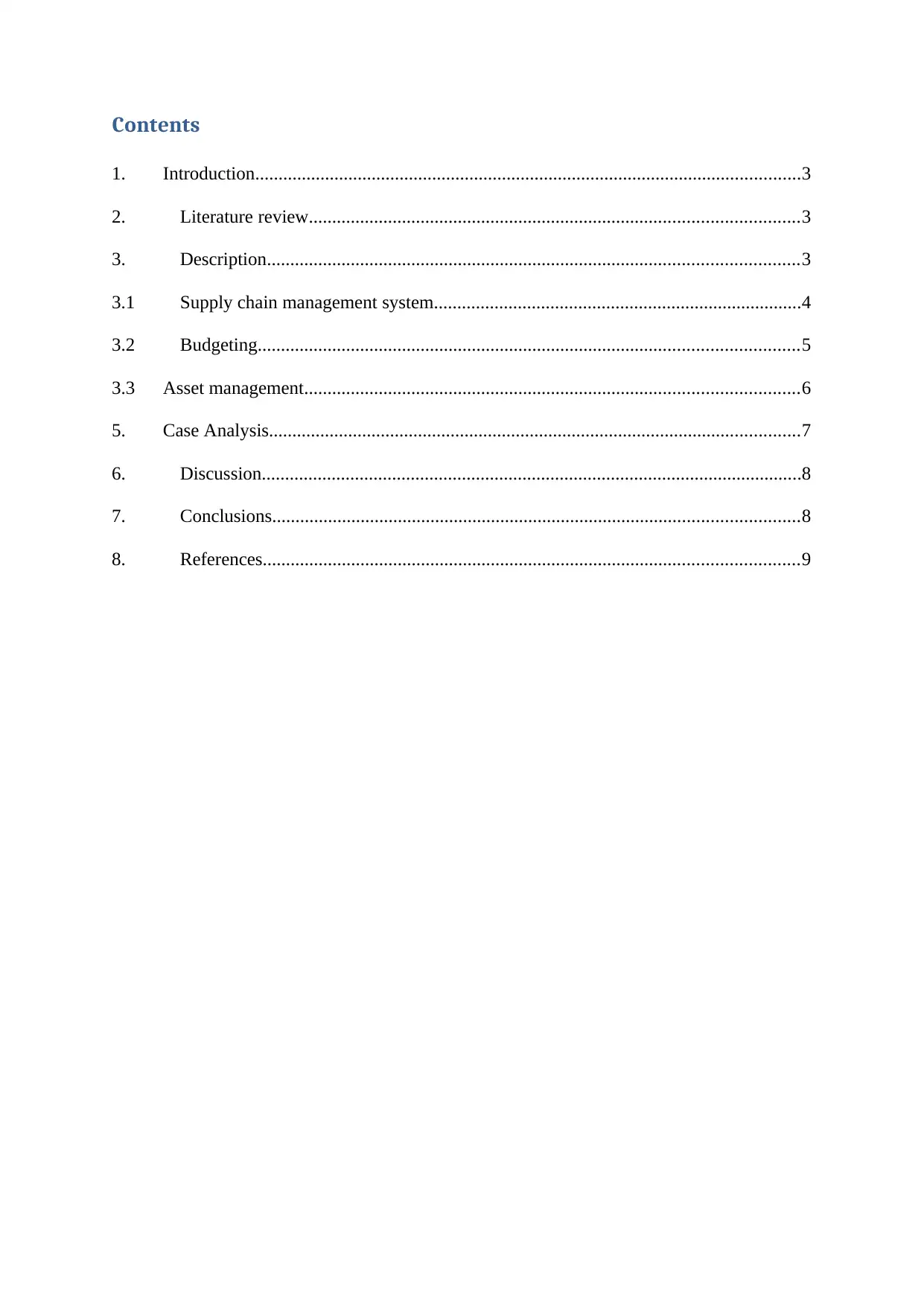
Contents
1. Introduction.....................................................................................................................3
2. Literature review.........................................................................................................3
3. Description..................................................................................................................3
3.1 Supply chain management system...............................................................................4
3.2 Budgeting....................................................................................................................5
3.3 Asset management..........................................................................................................6
5. Case Analysis..................................................................................................................7
6. Discussion....................................................................................................................8
7. Conclusions.................................................................................................................8
8. References...................................................................................................................9
1. Introduction.....................................................................................................................3
2. Literature review.........................................................................................................3
3. Description..................................................................................................................3
3.1 Supply chain management system...............................................................................4
3.2 Budgeting....................................................................................................................5
3.3 Asset management..........................................................................................................6
5. Case Analysis..................................................................................................................7
6. Discussion....................................................................................................................8
7. Conclusions.................................................................................................................8
8. References...................................................................................................................9
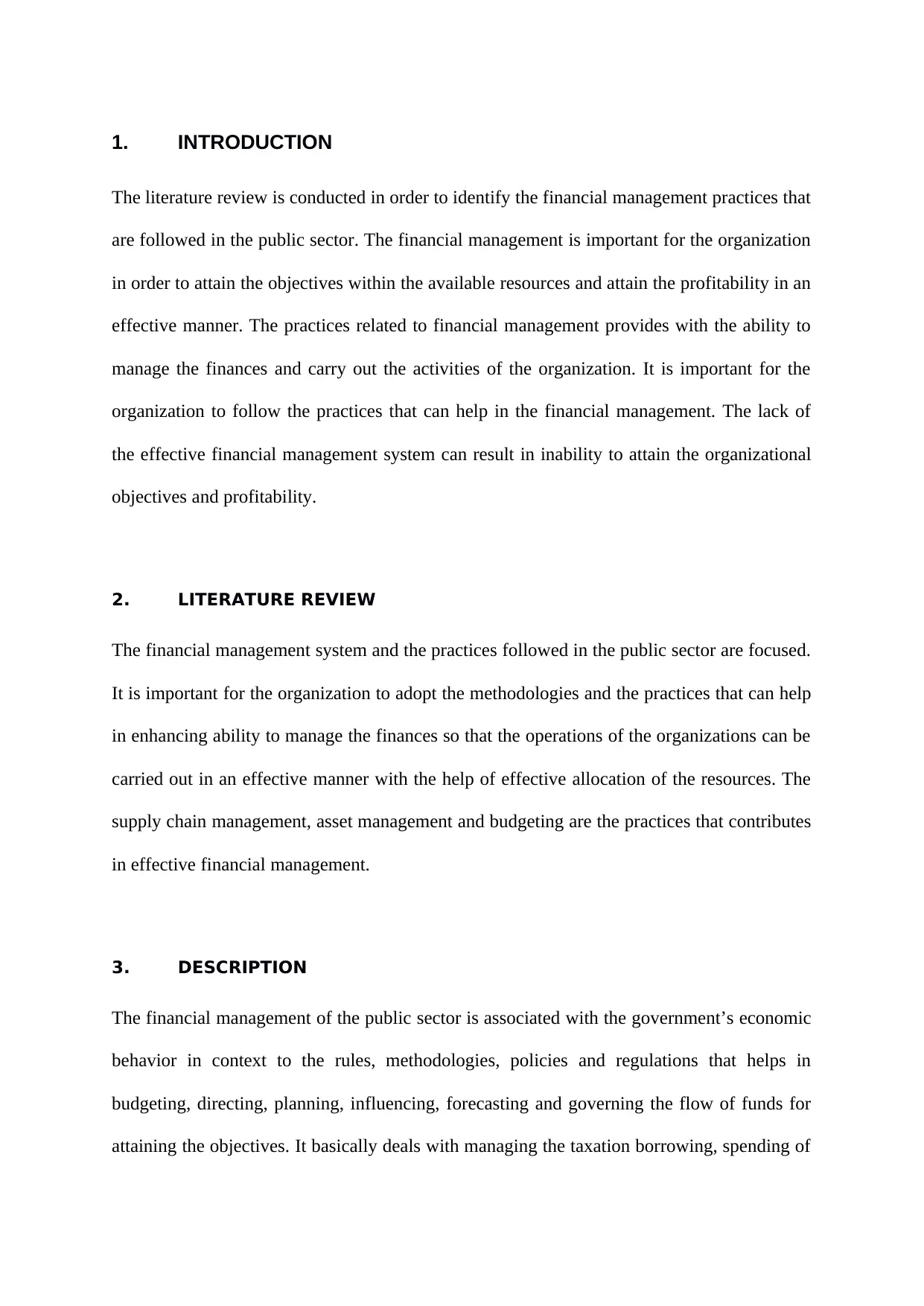
1. INTRODUCTION
The literature review is conducted in order to identify the financial management practices that
are followed in the public sector. The financial management is important for the organization
in order to attain the objectives within the available resources and attain the profitability in an
effective manner. The practices related to financial management provides with the ability to
manage the finances and carry out the activities of the organization. It is important for the
organization to follow the practices that can help in the financial management. The lack of
the effective financial management system can result in inability to attain the organizational
objectives and profitability.
2. LITERATURE REVIEW
The financial management system and the practices followed in the public sector are focused.
It is important for the organization to adopt the methodologies and the practices that can help
in enhancing ability to manage the finances so that the operations of the organizations can be
carried out in an effective manner with the help of effective allocation of the resources. The
supply chain management, asset management and budgeting are the practices that contributes
in effective financial management.
3. DESCRIPTION
The financial management of the public sector is associated with the government’s economic
behavior in context to the rules, methodologies, policies and regulations that helps in
budgeting, directing, planning, influencing, forecasting and governing the flow of funds for
attaining the objectives. It basically deals with managing the taxation borrowing, spending of
The literature review is conducted in order to identify the financial management practices that
are followed in the public sector. The financial management is important for the organization
in order to attain the objectives within the available resources and attain the profitability in an
effective manner. The practices related to financial management provides with the ability to
manage the finances and carry out the activities of the organization. It is important for the
organization to follow the practices that can help in the financial management. The lack of
the effective financial management system can result in inability to attain the organizational
objectives and profitability.
2. LITERATURE REVIEW
The financial management system and the practices followed in the public sector are focused.
It is important for the organization to adopt the methodologies and the practices that can help
in enhancing ability to manage the finances so that the operations of the organizations can be
carried out in an effective manner with the help of effective allocation of the resources. The
supply chain management, asset management and budgeting are the practices that contributes
in effective financial management.
3. DESCRIPTION
The financial management of the public sector is associated with the government’s economic
behavior in context to the rules, methodologies, policies and regulations that helps in
budgeting, directing, planning, influencing, forecasting and governing the flow of funds for
attaining the objectives. It basically deals with managing the taxation borrowing, spending of
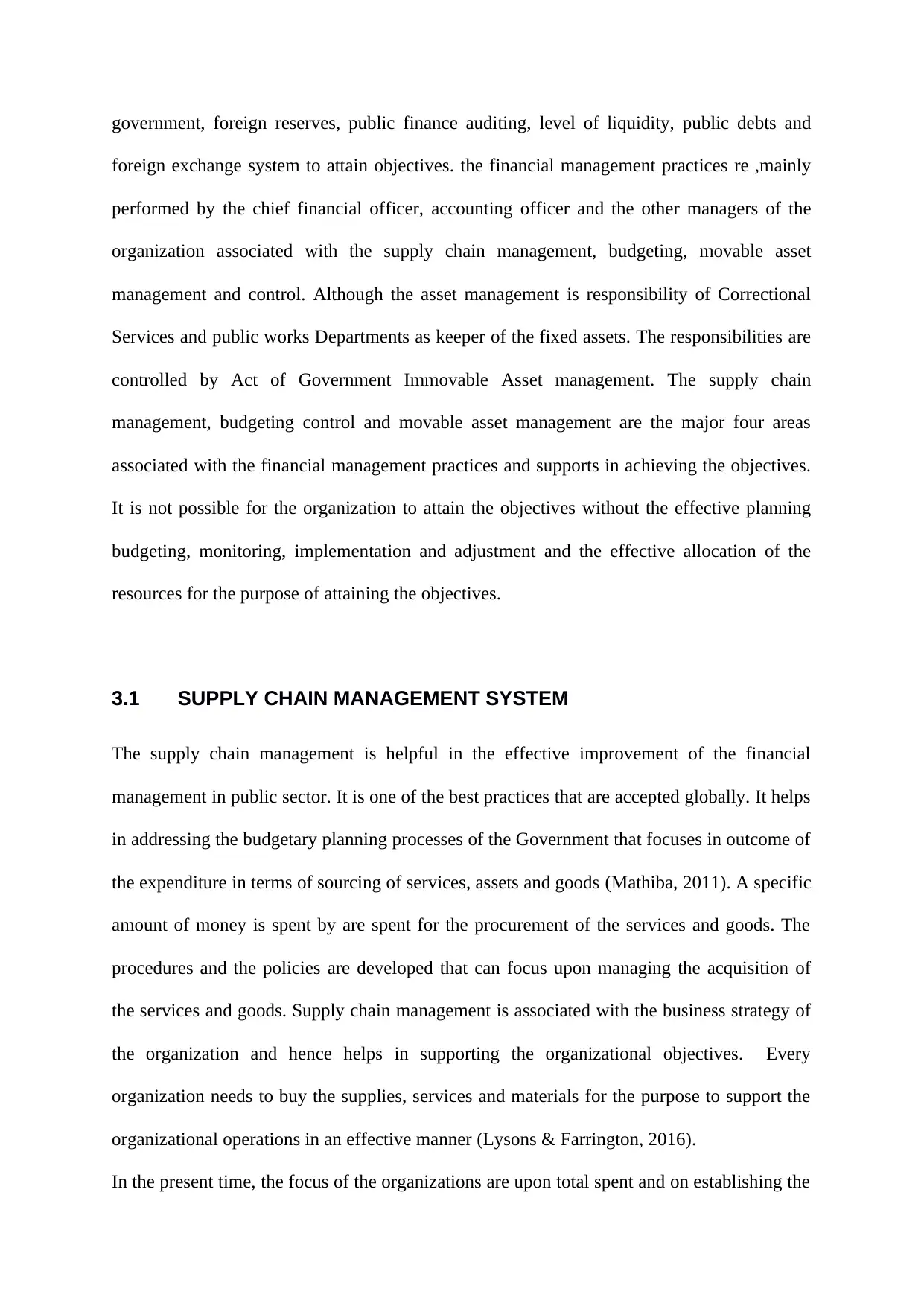
government, foreign reserves, public finance auditing, level of liquidity, public debts and
foreign exchange system to attain objectives. the financial management practices re ,mainly
performed by the chief financial officer, accounting officer and the other managers of the
organization associated with the supply chain management, budgeting, movable asset
management and control. Although the asset management is responsibility of Correctional
Services and public works Departments as keeper of the fixed assets. The responsibilities are
controlled by Act of Government Immovable Asset management. The supply chain
management, budgeting control and movable asset management are the major four areas
associated with the financial management practices and supports in achieving the objectives.
It is not possible for the organization to attain the objectives without the effective planning
budgeting, monitoring, implementation and adjustment and the effective allocation of the
resources for the purpose of attaining the objectives.
3.1 SUPPLY CHAIN MANAGEMENT SYSTEM
The supply chain management is helpful in the effective improvement of the financial
management in public sector. It is one of the best practices that are accepted globally. It helps
in addressing the budgetary planning processes of the Government that focuses in outcome of
the expenditure in terms of sourcing of services, assets and goods (Mathiba, 2011). A specific
amount of money is spent by are spent for the procurement of the services and goods. The
procedures and the policies are developed that can focus upon managing the acquisition of
the services and goods. Supply chain management is associated with the business strategy of
the organization and hence helps in supporting the organizational objectives. Every
organization needs to buy the supplies, services and materials for the purpose to support the
organizational operations in an effective manner (Lysons & Farrington, 2016).
In the present time, the focus of the organizations are upon total spent and on establishing the
foreign exchange system to attain objectives. the financial management practices re ,mainly
performed by the chief financial officer, accounting officer and the other managers of the
organization associated with the supply chain management, budgeting, movable asset
management and control. Although the asset management is responsibility of Correctional
Services and public works Departments as keeper of the fixed assets. The responsibilities are
controlled by Act of Government Immovable Asset management. The supply chain
management, budgeting control and movable asset management are the major four areas
associated with the financial management practices and supports in achieving the objectives.
It is not possible for the organization to attain the objectives without the effective planning
budgeting, monitoring, implementation and adjustment and the effective allocation of the
resources for the purpose of attaining the objectives.
3.1 SUPPLY CHAIN MANAGEMENT SYSTEM
The supply chain management is helpful in the effective improvement of the financial
management in public sector. It is one of the best practices that are accepted globally. It helps
in addressing the budgetary planning processes of the Government that focuses in outcome of
the expenditure in terms of sourcing of services, assets and goods (Mathiba, 2011). A specific
amount of money is spent by are spent for the procurement of the services and goods. The
procedures and the policies are developed that can focus upon managing the acquisition of
the services and goods. Supply chain management is associated with the business strategy of
the organization and hence helps in supporting the organizational objectives. Every
organization needs to buy the supplies, services and materials for the purpose to support the
organizational operations in an effective manner (Lysons & Farrington, 2016).
In the present time, the focus of the organizations are upon total spent and on establishing the
Secure Best Marks with AI Grader
Need help grading? Try our AI Grader for instant feedback on your assignments.
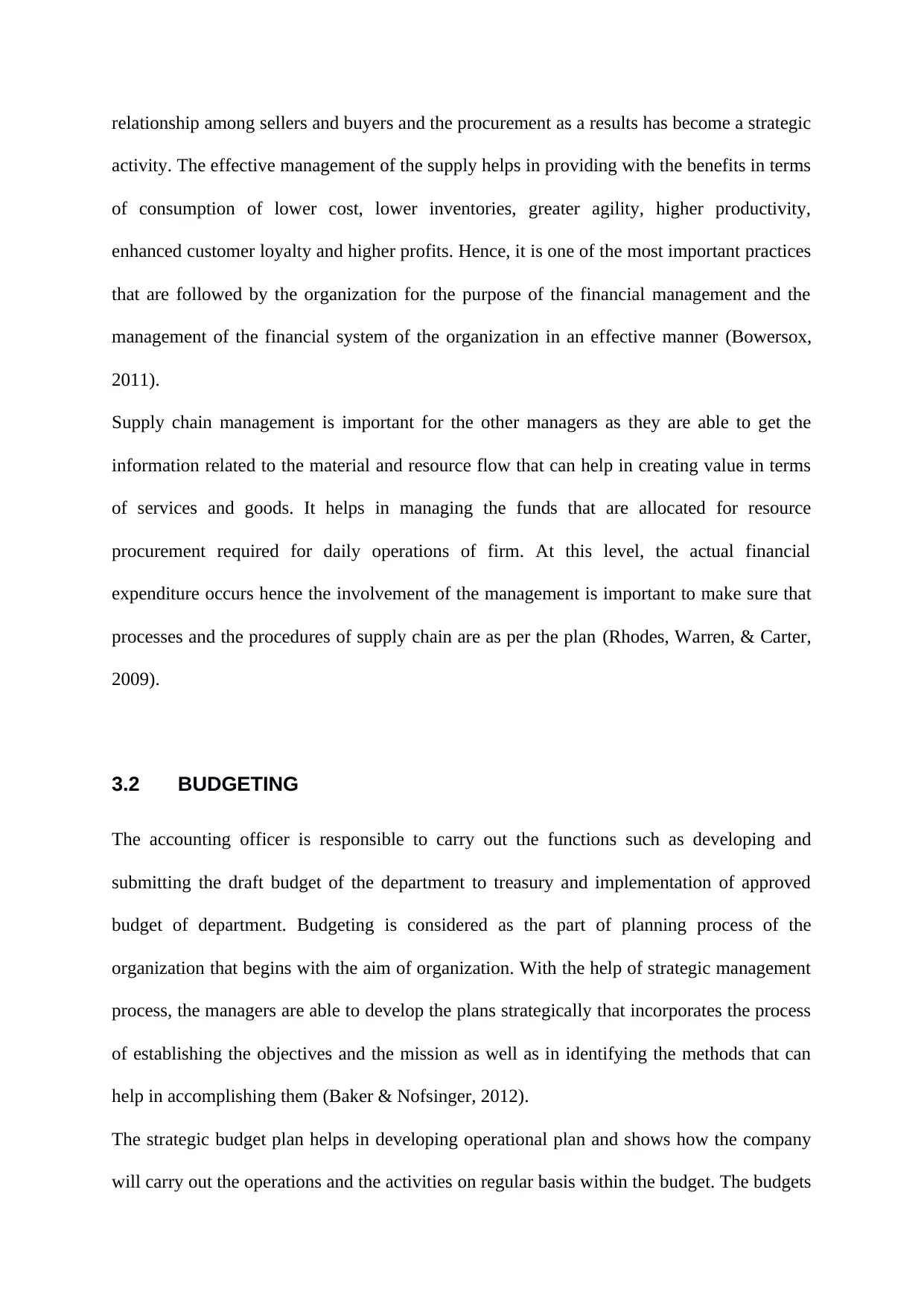
relationship among sellers and buyers and the procurement as a results has become a strategic
activity. The effective management of the supply helps in providing with the benefits in terms
of consumption of lower cost, lower inventories, greater agility, higher productivity,
enhanced customer loyalty and higher profits. Hence, it is one of the most important practices
that are followed by the organization for the purpose of the financial management and the
management of the financial system of the organization in an effective manner (Bowersox,
2011).
Supply chain management is important for the other managers as they are able to get the
information related to the material and resource flow that can help in creating value in terms
of services and goods. It helps in managing the funds that are allocated for resource
procurement required for daily operations of firm. At this level, the actual financial
expenditure occurs hence the involvement of the management is important to make sure that
processes and the procedures of supply chain are as per the plan (Rhodes, Warren, & Carter,
2009).
3.2 BUDGETING
The accounting officer is responsible to carry out the functions such as developing and
submitting the draft budget of the department to treasury and implementation of approved
budget of department. Budgeting is considered as the part of planning process of the
organization that begins with the aim of organization. With the help of strategic management
process, the managers are able to develop the plans strategically that incorporates the process
of establishing the objectives and the mission as well as in identifying the methods that can
help in accomplishing them (Baker & Nofsinger, 2012).
The strategic budget plan helps in developing operational plan and shows how the company
will carry out the operations and the activities on regular basis within the budget. The budgets
activity. The effective management of the supply helps in providing with the benefits in terms
of consumption of lower cost, lower inventories, greater agility, higher productivity,
enhanced customer loyalty and higher profits. Hence, it is one of the most important practices
that are followed by the organization for the purpose of the financial management and the
management of the financial system of the organization in an effective manner (Bowersox,
2011).
Supply chain management is important for the other managers as they are able to get the
information related to the material and resource flow that can help in creating value in terms
of services and goods. It helps in managing the funds that are allocated for resource
procurement required for daily operations of firm. At this level, the actual financial
expenditure occurs hence the involvement of the management is important to make sure that
processes and the procedures of supply chain are as per the plan (Rhodes, Warren, & Carter,
2009).
3.2 BUDGETING
The accounting officer is responsible to carry out the functions such as developing and
submitting the draft budget of the department to treasury and implementation of approved
budget of department. Budgeting is considered as the part of planning process of the
organization that begins with the aim of organization. With the help of strategic management
process, the managers are able to develop the plans strategically that incorporates the process
of establishing the objectives and the mission as well as in identifying the methods that can
help in accomplishing them (Baker & Nofsinger, 2012).
The strategic budget plan helps in developing operational plan and shows how the company
will carry out the operations and the activities on regular basis within the budget. The budgets
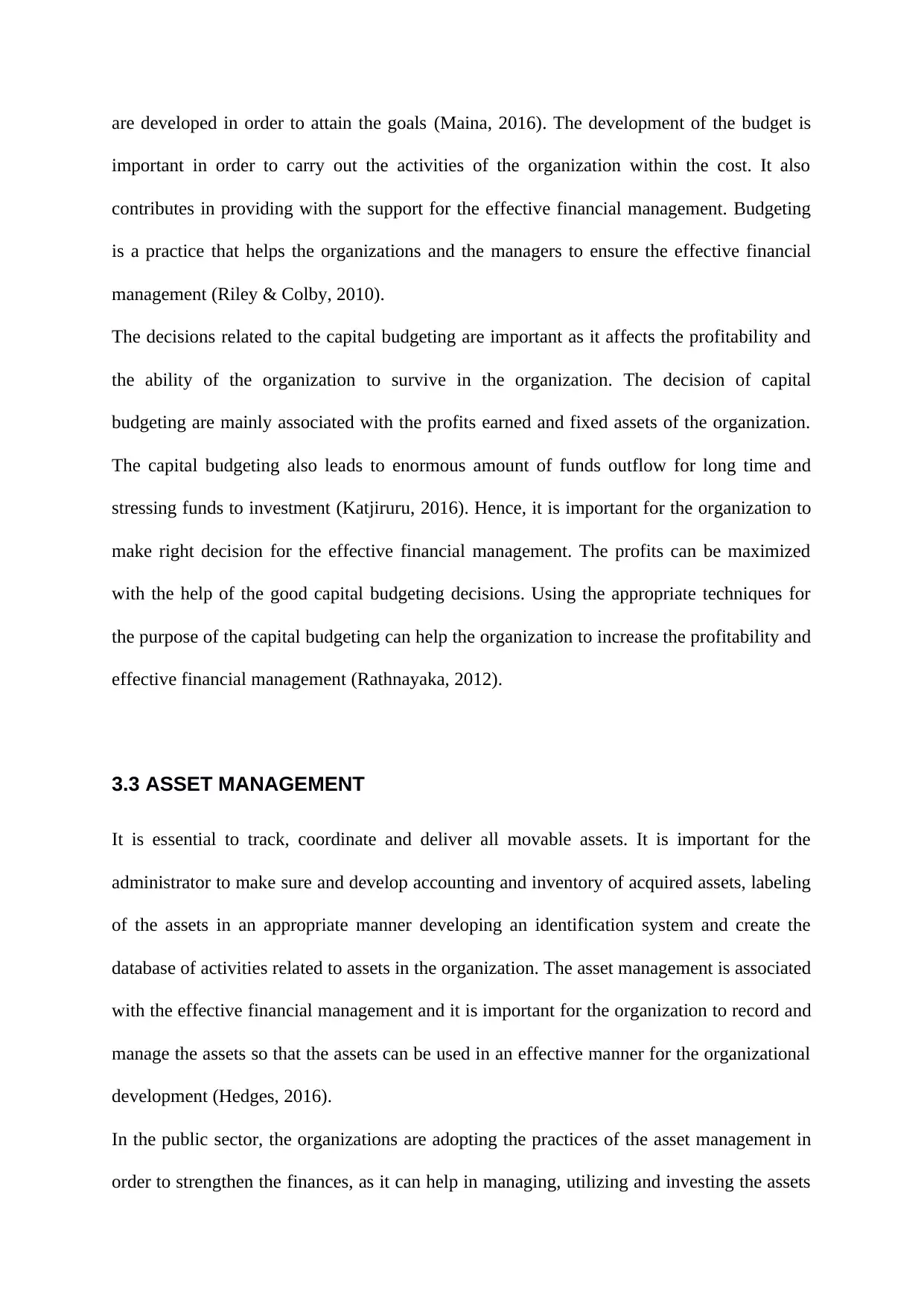
are developed in order to attain the goals (Maina, 2016). The development of the budget is
important in order to carry out the activities of the organization within the cost. It also
contributes in providing with the support for the effective financial management. Budgeting
is a practice that helps the organizations and the managers to ensure the effective financial
management (Riley & Colby, 2010).
The decisions related to the capital budgeting are important as it affects the profitability and
the ability of the organization to survive in the organization. The decision of capital
budgeting are mainly associated with the profits earned and fixed assets of the organization.
The capital budgeting also leads to enormous amount of funds outflow for long time and
stressing funds to investment (Katjiruru, 2016). Hence, it is important for the organization to
make right decision for the effective financial management. The profits can be maximized
with the help of the good capital budgeting decisions. Using the appropriate techniques for
the purpose of the capital budgeting can help the organization to increase the profitability and
effective financial management (Rathnayaka, 2012).
3.3 ASSET MANAGEMENT
It is essential to track, coordinate and deliver all movable assets. It is important for the
administrator to make sure and develop accounting and inventory of acquired assets, labeling
of the assets in an appropriate manner developing an identification system and create the
database of activities related to assets in the organization. The asset management is associated
with the effective financial management and it is important for the organization to record and
manage the assets so that the assets can be used in an effective manner for the organizational
development (Hedges, 2016).
In the public sector, the organizations are adopting the practices of the asset management in
order to strengthen the finances, as it can help in managing, utilizing and investing the assets
important in order to carry out the activities of the organization within the cost. It also
contributes in providing with the support for the effective financial management. Budgeting
is a practice that helps the organizations and the managers to ensure the effective financial
management (Riley & Colby, 2010).
The decisions related to the capital budgeting are important as it affects the profitability and
the ability of the organization to survive in the organization. The decision of capital
budgeting are mainly associated with the profits earned and fixed assets of the organization.
The capital budgeting also leads to enormous amount of funds outflow for long time and
stressing funds to investment (Katjiruru, 2016). Hence, it is important for the organization to
make right decision for the effective financial management. The profits can be maximized
with the help of the good capital budgeting decisions. Using the appropriate techniques for
the purpose of the capital budgeting can help the organization to increase the profitability and
effective financial management (Rathnayaka, 2012).
3.3 ASSET MANAGEMENT
It is essential to track, coordinate and deliver all movable assets. It is important for the
administrator to make sure and develop accounting and inventory of acquired assets, labeling
of the assets in an appropriate manner developing an identification system and create the
database of activities related to assets in the organization. The asset management is associated
with the effective financial management and it is important for the organization to record and
manage the assets so that the assets can be used in an effective manner for the organizational
development (Hedges, 2016).
In the public sector, the organizations are adopting the practices of the asset management in
order to strengthen the finances, as it can help in managing, utilizing and investing the assets
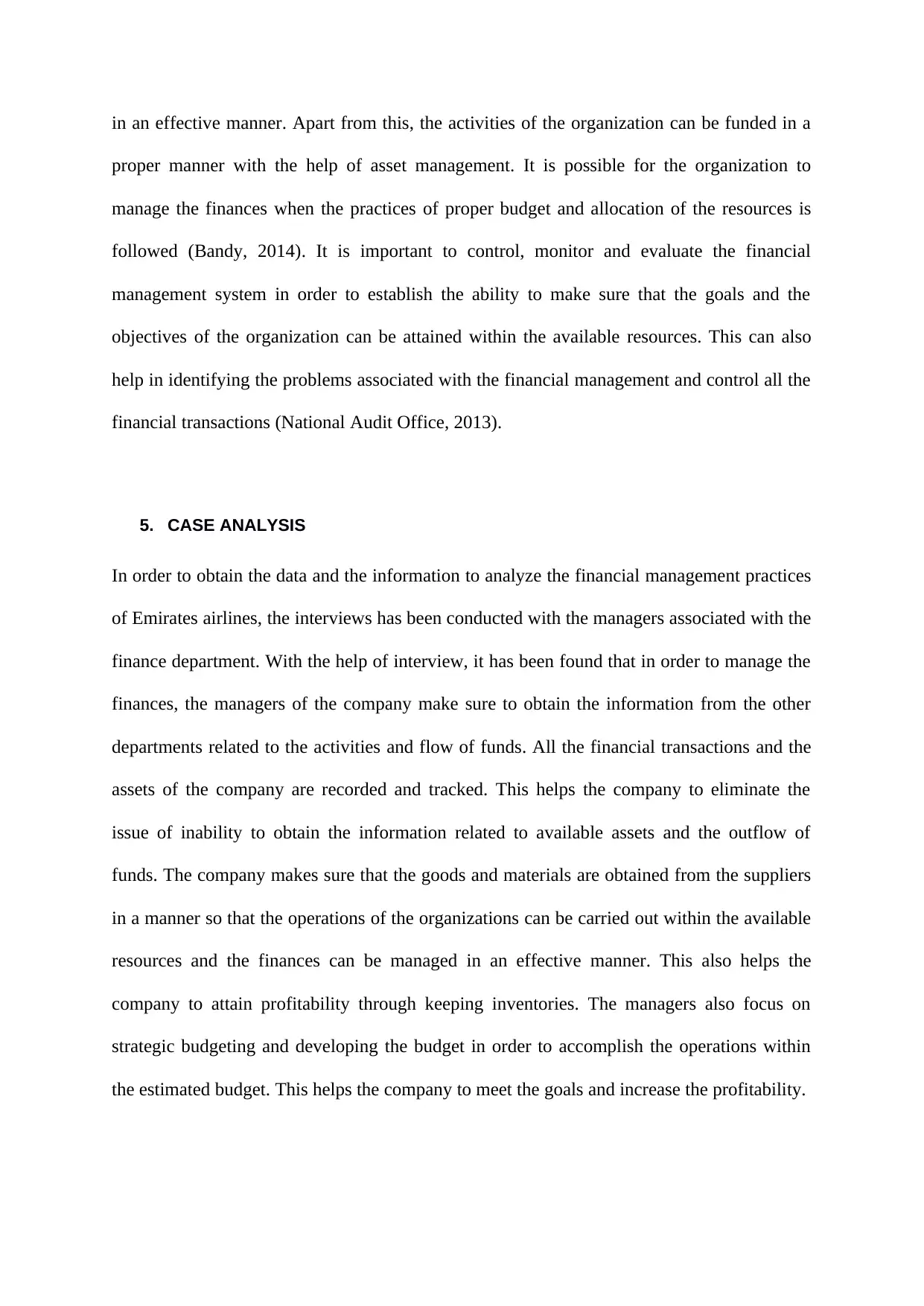
in an effective manner. Apart from this, the activities of the organization can be funded in a
proper manner with the help of asset management. It is possible for the organization to
manage the finances when the practices of proper budget and allocation of the resources is
followed (Bandy, 2014). It is important to control, monitor and evaluate the financial
management system in order to establish the ability to make sure that the goals and the
objectives of the organization can be attained within the available resources. This can also
help in identifying the problems associated with the financial management and control all the
financial transactions (National Audit Office, 2013).
5. CASE ANALYSIS
In order to obtain the data and the information to analyze the financial management practices
of Emirates airlines, the interviews has been conducted with the managers associated with the
finance department. With the help of interview, it has been found that in order to manage the
finances, the managers of the company make sure to obtain the information from the other
departments related to the activities and flow of funds. All the financial transactions and the
assets of the company are recorded and tracked. This helps the company to eliminate the
issue of inability to obtain the information related to available assets and the outflow of
funds. The company makes sure that the goods and materials are obtained from the suppliers
in a manner so that the operations of the organizations can be carried out within the available
resources and the finances can be managed in an effective manner. This also helps the
company to attain profitability through keeping inventories. The managers also focus on
strategic budgeting and developing the budget in order to accomplish the operations within
the estimated budget. This helps the company to meet the goals and increase the profitability.
proper manner with the help of asset management. It is possible for the organization to
manage the finances when the practices of proper budget and allocation of the resources is
followed (Bandy, 2014). It is important to control, monitor and evaluate the financial
management system in order to establish the ability to make sure that the goals and the
objectives of the organization can be attained within the available resources. This can also
help in identifying the problems associated with the financial management and control all the
financial transactions (National Audit Office, 2013).
5. CASE ANALYSIS
In order to obtain the data and the information to analyze the financial management practices
of Emirates airlines, the interviews has been conducted with the managers associated with the
finance department. With the help of interview, it has been found that in order to manage the
finances, the managers of the company make sure to obtain the information from the other
departments related to the activities and flow of funds. All the financial transactions and the
assets of the company are recorded and tracked. This helps the company to eliminate the
issue of inability to obtain the information related to available assets and the outflow of
funds. The company makes sure that the goods and materials are obtained from the suppliers
in a manner so that the operations of the organizations can be carried out within the available
resources and the finances can be managed in an effective manner. This also helps the
company to attain profitability through keeping inventories. The managers also focus on
strategic budgeting and developing the budget in order to accomplish the operations within
the estimated budget. This helps the company to meet the goals and increase the profitability.
Paraphrase This Document
Need a fresh take? Get an instant paraphrase of this document with our AI Paraphraser
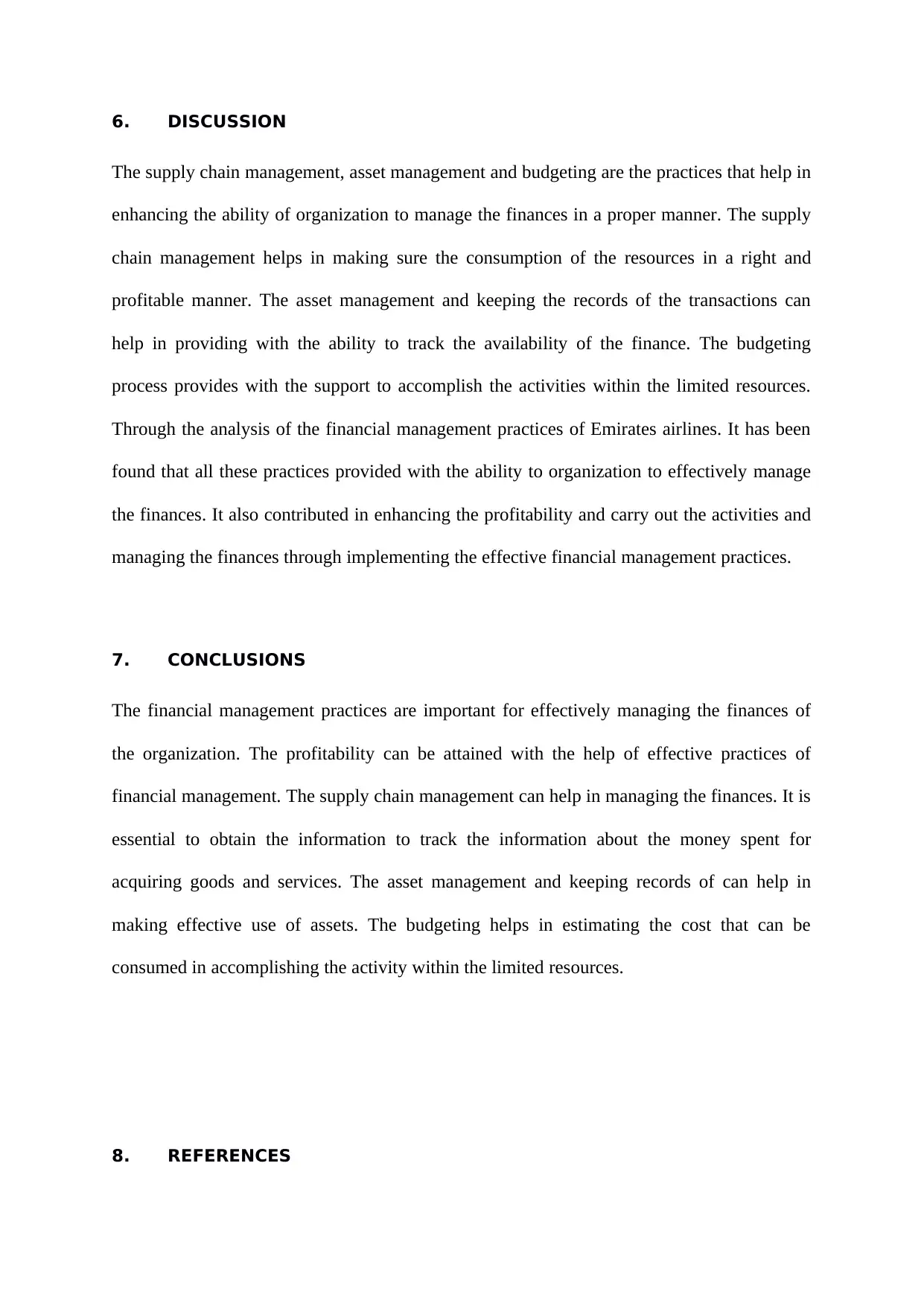
6. DISCUSSION
The supply chain management, asset management and budgeting are the practices that help in
enhancing the ability of organization to manage the finances in a proper manner. The supply
chain management helps in making sure the consumption of the resources in a right and
profitable manner. The asset management and keeping the records of the transactions can
help in providing with the ability to track the availability of the finance. The budgeting
process provides with the support to accomplish the activities within the limited resources.
Through the analysis of the financial management practices of Emirates airlines. It has been
found that all these practices provided with the ability to organization to effectively manage
the finances. It also contributed in enhancing the profitability and carry out the activities and
managing the finances through implementing the effective financial management practices.
7. CONCLUSIONS
The financial management practices are important for effectively managing the finances of
the organization. The profitability can be attained with the help of effective practices of
financial management. The supply chain management can help in managing the finances. It is
essential to obtain the information to track the information about the money spent for
acquiring goods and services. The asset management and keeping records of can help in
making effective use of assets. The budgeting helps in estimating the cost that can be
consumed in accomplishing the activity within the limited resources.
8. REFERENCES
The supply chain management, asset management and budgeting are the practices that help in
enhancing the ability of organization to manage the finances in a proper manner. The supply
chain management helps in making sure the consumption of the resources in a right and
profitable manner. The asset management and keeping the records of the transactions can
help in providing with the ability to track the availability of the finance. The budgeting
process provides with the support to accomplish the activities within the limited resources.
Through the analysis of the financial management practices of Emirates airlines. It has been
found that all these practices provided with the ability to organization to effectively manage
the finances. It also contributed in enhancing the profitability and carry out the activities and
managing the finances through implementing the effective financial management practices.
7. CONCLUSIONS
The financial management practices are important for effectively managing the finances of
the organization. The profitability can be attained with the help of effective practices of
financial management. The supply chain management can help in managing the finances. It is
essential to obtain the information to track the information about the money spent for
acquiring goods and services. The asset management and keeping records of can help in
making effective use of assets. The budgeting helps in estimating the cost that can be
consumed in accomplishing the activity within the limited resources.
8. REFERENCES
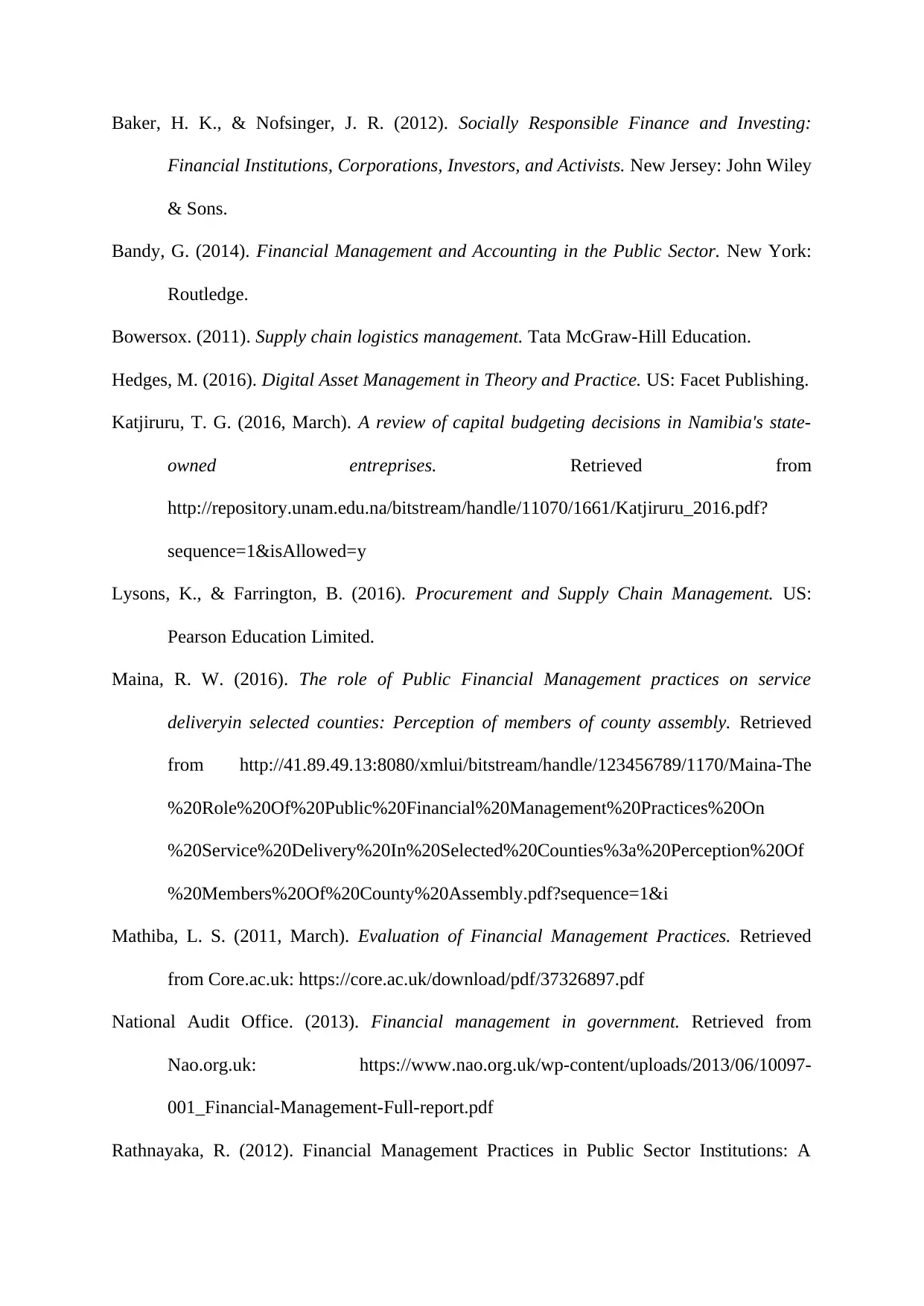
Baker, H. K., & Nofsinger, J. R. (2012). Socially Responsible Finance and Investing:
Financial Institutions, Corporations, Investors, and Activists. New Jersey: John Wiley
& Sons.
Bandy, G. (2014). Financial Management and Accounting in the Public Sector. New York:
Routledge.
Bowersox. (2011). Supply chain logistics management. Tata McGraw-Hill Education.
Hedges, M. (2016). Digital Asset Management in Theory and Practice. US: Facet Publishing.
Katjiruru, T. G. (2016, March). A review of capital budgeting decisions in Namibia's state-
owned entreprises. Retrieved from
http://repository.unam.edu.na/bitstream/handle/11070/1661/Katjiruru_2016.pdf?
sequence=1&isAllowed=y
Lysons, K., & Farrington, B. (2016). Procurement and Supply Chain Management. US:
Pearson Education Limited.
Maina, R. W. (2016). The role of Public Financial Management practices on service
deliveryin selected counties: Perception of members of county assembly. Retrieved
from http://41.89.49.13:8080/xmlui/bitstream/handle/123456789/1170/Maina-The
%20Role%20Of%20Public%20Financial%20Management%20Practices%20On
%20Service%20Delivery%20In%20Selected%20Counties%3a%20Perception%20Of
%20Members%20Of%20County%20Assembly.pdf?sequence=1&i
Mathiba, L. S. (2011, March). Evaluation of Financial Management Practices. Retrieved
from Core.ac.uk: https://core.ac.uk/download/pdf/37326897.pdf
National Audit Office. (2013). Financial management in government. Retrieved from
Nao.org.uk: https://www.nao.org.uk/wp-content/uploads/2013/06/10097-
001_Financial-Management-Full-report.pdf
Rathnayaka, R. (2012). Financial Management Practices in Public Sector Institutions: A
Financial Institutions, Corporations, Investors, and Activists. New Jersey: John Wiley
& Sons.
Bandy, G. (2014). Financial Management and Accounting in the Public Sector. New York:
Routledge.
Bowersox. (2011). Supply chain logistics management. Tata McGraw-Hill Education.
Hedges, M. (2016). Digital Asset Management in Theory and Practice. US: Facet Publishing.
Katjiruru, T. G. (2016, March). A review of capital budgeting decisions in Namibia's state-
owned entreprises. Retrieved from
http://repository.unam.edu.na/bitstream/handle/11070/1661/Katjiruru_2016.pdf?
sequence=1&isAllowed=y
Lysons, K., & Farrington, B. (2016). Procurement and Supply Chain Management. US:
Pearson Education Limited.
Maina, R. W. (2016). The role of Public Financial Management practices on service
deliveryin selected counties: Perception of members of county assembly. Retrieved
from http://41.89.49.13:8080/xmlui/bitstream/handle/123456789/1170/Maina-The
%20Role%20Of%20Public%20Financial%20Management%20Practices%20On
%20Service%20Delivery%20In%20Selected%20Counties%3a%20Perception%20Of
%20Members%20Of%20County%20Assembly.pdf?sequence=1&i
Mathiba, L. S. (2011, March). Evaluation of Financial Management Practices. Retrieved
from Core.ac.uk: https://core.ac.uk/download/pdf/37326897.pdf
National Audit Office. (2013). Financial management in government. Retrieved from
Nao.org.uk: https://www.nao.org.uk/wp-content/uploads/2013/06/10097-
001_Financial-Management-Full-report.pdf
Rathnayaka, R. (2012). Financial Management Practices in Public Sector Institutions: A
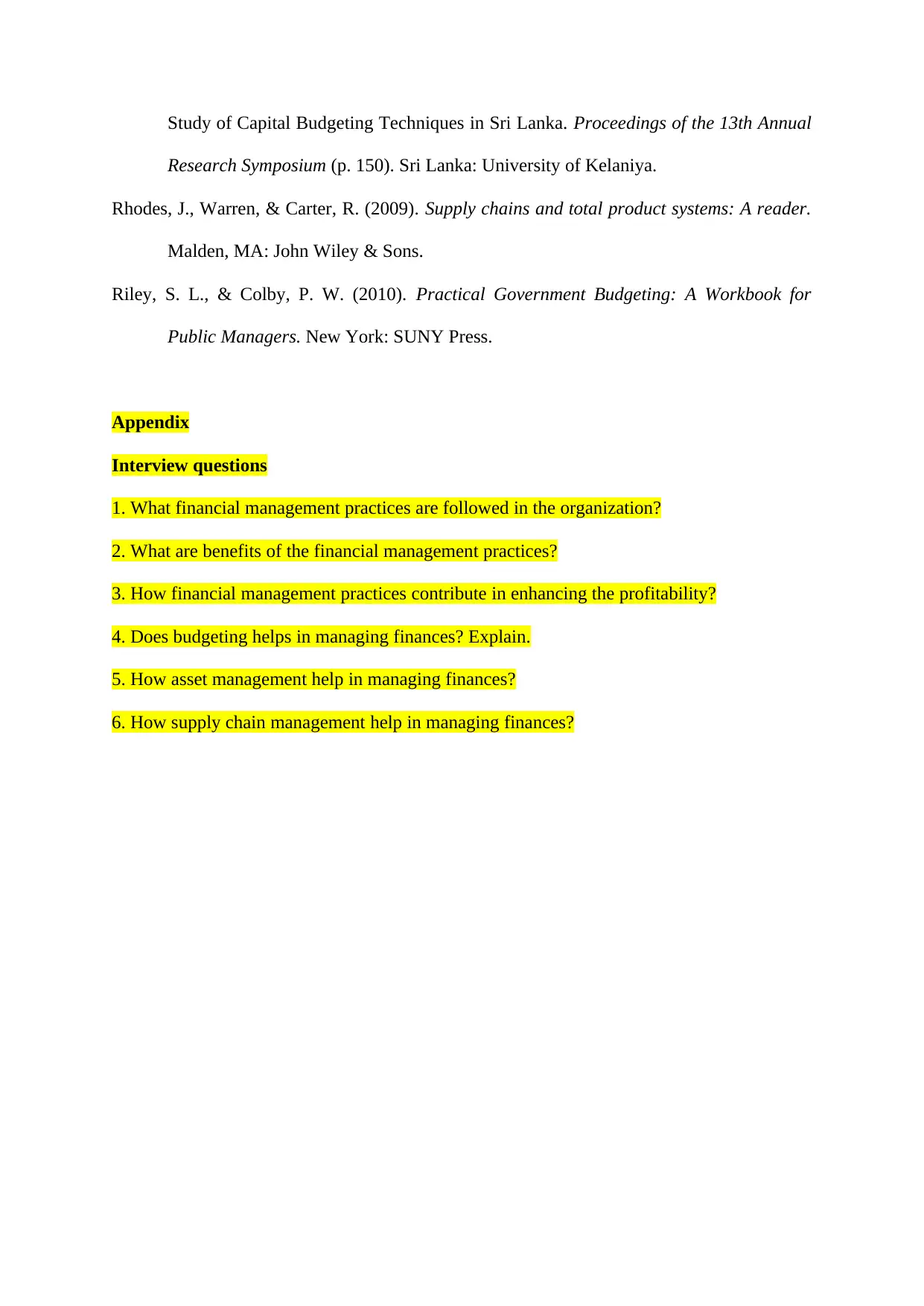
Study of Capital Budgeting Techniques in Sri Lanka. Proceedings of the 13th Annual
Research Symposium (p. 150). Sri Lanka: University of Kelaniya.
Rhodes, J., Warren, & Carter, R. (2009). Supply chains and total product systems: A reader.
Malden, MA: John Wiley & Sons.
Riley, S. L., & Colby, P. W. (2010). Practical Government Budgeting: A Workbook for
Public Managers. New York: SUNY Press.
Appendix
Interview questions
1. What financial management practices are followed in the organization?
2. What are benefits of the financial management practices?
3. How financial management practices contribute in enhancing the profitability?
4. Does budgeting helps in managing finances? Explain.
5. How asset management help in managing finances?
6. How supply chain management help in managing finances?
Research Symposium (p. 150). Sri Lanka: University of Kelaniya.
Rhodes, J., Warren, & Carter, R. (2009). Supply chains and total product systems: A reader.
Malden, MA: John Wiley & Sons.
Riley, S. L., & Colby, P. W. (2010). Practical Government Budgeting: A Workbook for
Public Managers. New York: SUNY Press.
Appendix
Interview questions
1. What financial management practices are followed in the organization?
2. What are benefits of the financial management practices?
3. How financial management practices contribute in enhancing the profitability?
4. Does budgeting helps in managing finances? Explain.
5. How asset management help in managing finances?
6. How supply chain management help in managing finances?
1 out of 10
Related Documents
Your All-in-One AI-Powered Toolkit for Academic Success.
+13062052269
info@desklib.com
Available 24*7 on WhatsApp / Email
![[object Object]](/_next/static/media/star-bottom.7253800d.svg)
Unlock your academic potential
© 2024 | Zucol Services PVT LTD | All rights reserved.




